CLIENT ADVISORY INFORMATION (PDF)
File information
This PDF 1.4 document has been generated by Adobe InDesign CS4 (6.0.6) / Adobe PDF Library 9.0, and has been sent on pdf-archive.com on 01/02/2016 at 23:15, from IP address 70.119.x.x.
The current document download page has been viewed 597 times.
File size: 373.25 KB (9 pages).
Privacy: public file
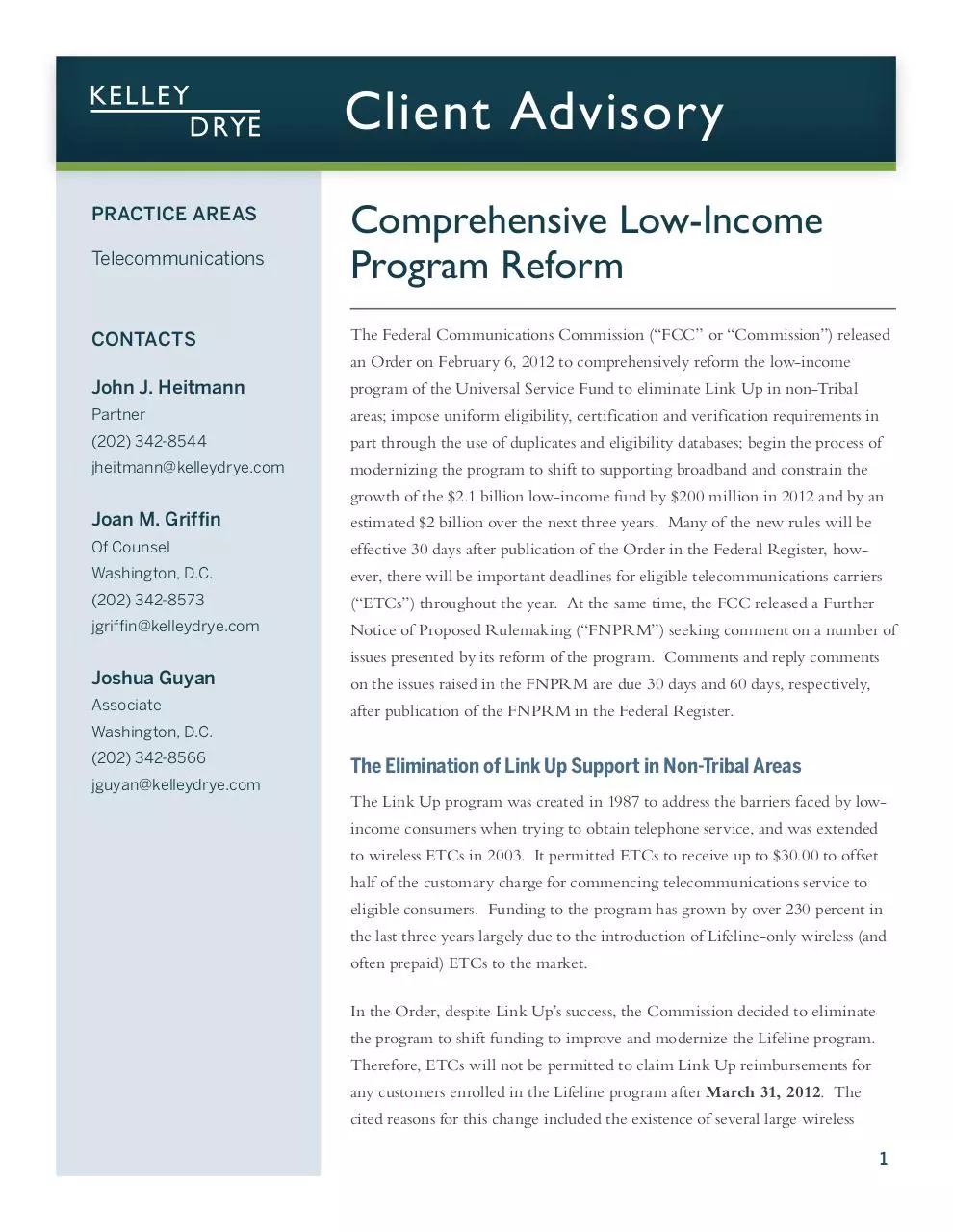

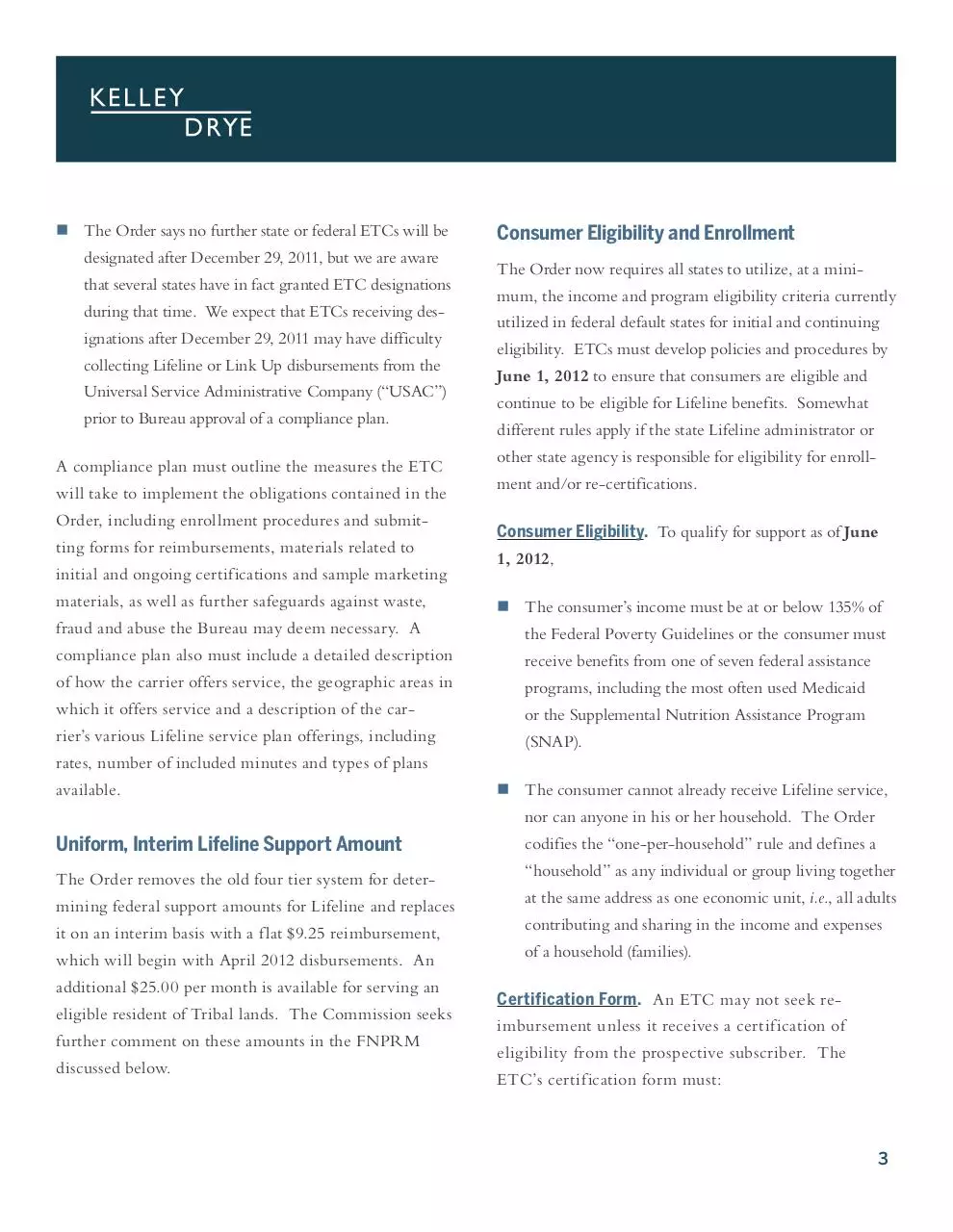
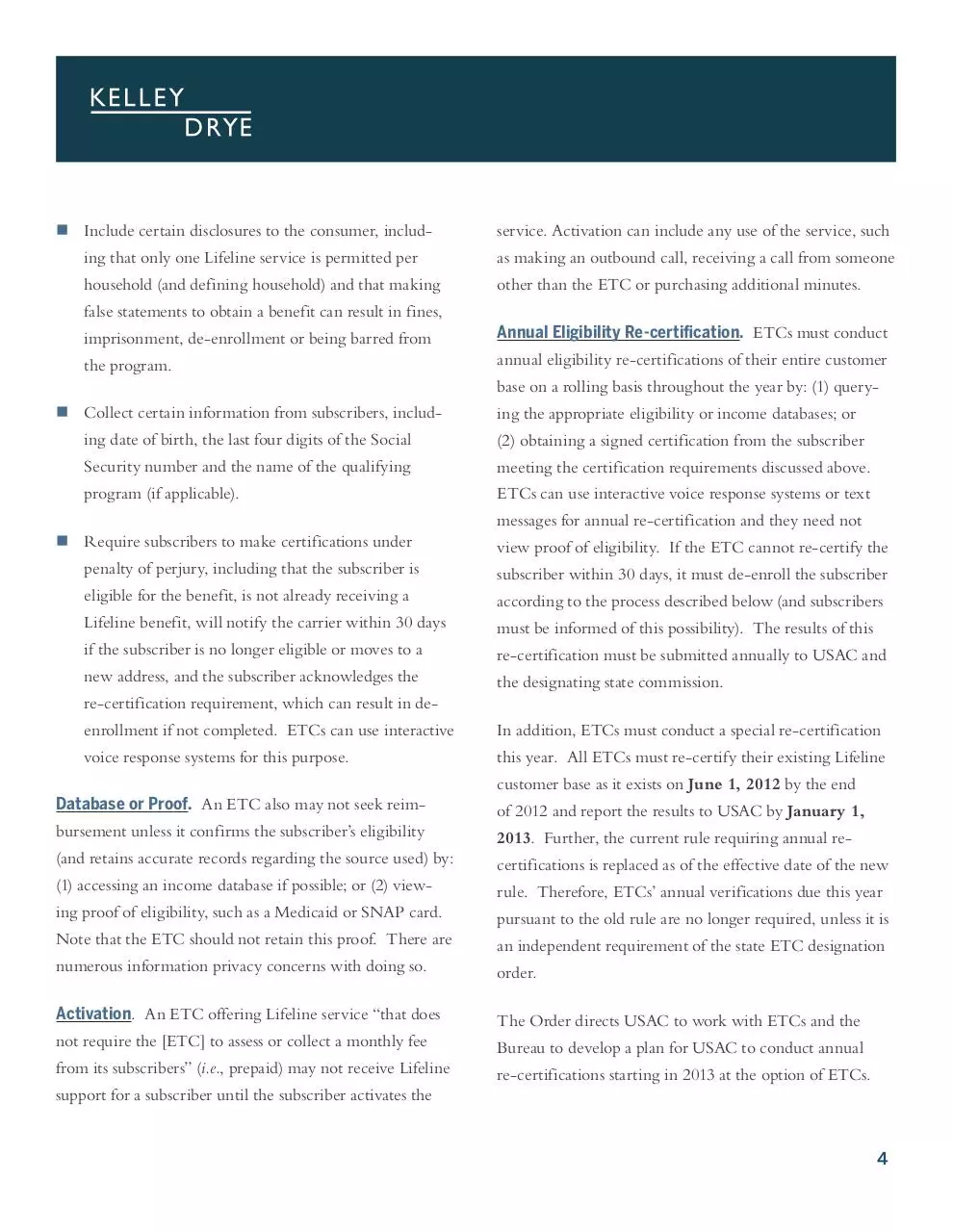
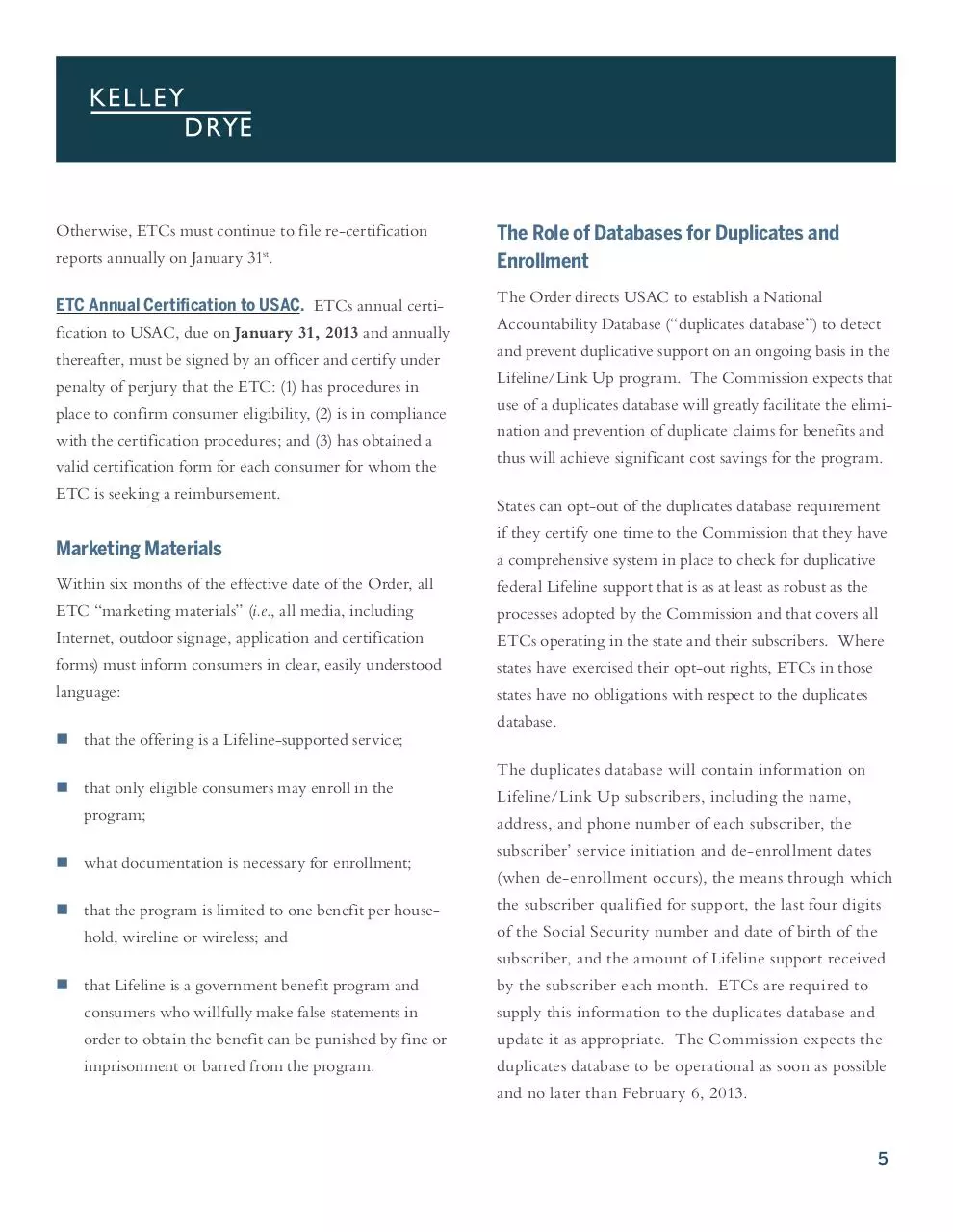
File preview
Client Advisory
Practice Areas
Telecommunications
Contacts
Comprehensive Low-Income
Program Reform
The Federal Communications Commission (“FCC” or “Commission”) released
an Order on February 6, 2012 to comprehensively reform the low-income
John J. Heitmann
program of the Universal Service Fund to eliminate Link Up in non-Tribal
Partner
areas; impose uniform eligibility, certification and verification requirements in
(202) 342-8544
part through the use of duplicates and eligibility databases; begin the process of
jheitmann@kelleydrye.com
modernizing the program to shift to supporting broadband and constrain the
growth of the $2.1 billion low-income fund by $200 million in 2012 and by an
Joan M. Griffin
estimated $2 billion over the next three years. Many of the new rules will be
Of Counsel
effective 30 days after publication of the Order in the Federal Register, how-
Washington, D.C.
ever, there will be important deadlines for eligible telecommunications carriers
(202) 342-8573
(“ETCs”) throughout the year. At the same time, the FCC released a Further
jgriffin@kelleydrye.com
Notice of Proposed Rulemaking (“FNPRM”) seeking comment on a number of
Joshua Guyan
Associate
issues presented by its reform of the program. Comments and reply comments
on the issues raised in the FNPRM are due 30 days and 60 days, respectively,
after publication of the FNPRM in the Federal Register.
Washington, D.C.
(202) 342-8566
jguyan@kelleydrye.com
The Elimination of Link Up Support in Non-Tribal Areas
The Link Up program was created in 1987 to address the barriers faced by lowincome consumers when trying to obtain telephone service, and was extended
to wireless ETCs in 2003. It permitted ETCs to receive up to $30.00 to offset
half of the customary charge for commencing telecommunications service to
eligible consumers. Funding to the program has grown by over 230 percent in
the last three years largely due to the introduction of Lifeline-only wireless (and
often prepaid) ETCs to the market.
In the Order, despite Link Up’s success, the Commission decided to eliminate
the program to shift funding to improve and modernize the Lifeline program.
Therefore, ETCs will not be permitted to claim Link Up reimbursements for
any customers enrolled in the Lifeline program after March 31, 2012. The
cited reasons for this change included the existence of several large wireless
1
Lifeline-only ETCs that provide Lifeline service without
for purposes of ETC designation to remove, among others,
charging customers an activation fee or collecting Link Up,
directory assistance and operator services from the list of
concerns that Link Up provided incentives to maximize
functionalities that an ETC could provide in order to be
reimbursements from the low-income fund, and concerns
considered a facilities-based provider of “voice telephony
that Link Up is not an efficient means of increasing phone
service.” This Order conforms the Lifeline rules, thereby
subscribership. Finally, due to the continuing deployment
precluding many Lifeline-only ETCs from meeting the
and access challenges on Tribal lands, the Commission
statutory requirement that an ETC provide the supported
determined that ETCs can still claim enhanced Link Up
service using its own facilities or a combination of its own
support for eligible residents, but only if the ETC also
facilities and resale. In the subsequent CAF Order on
receives high-cost support on Tribal lands.
Reconsideration, certain ETCs, which had been designated
as such prior to December 29, 2011, were given a grace
Phase Down and Elimination of Toll Limitation
Service (“TLS”) Support
TLS includes both toll blocking (prevents long distance
and international calls for which the subscriber would be
charged) and toll control (limits the amount of long distances
charges that can be incurred per month) and the FCC has
historically required ETCs to provide it for free to lowincome consumers. Due to decreases in long distance rates,
the Commission has decided to phase down and then elimi-
period until July 1, 2012 to continue to receive Lifeline
reimbursements and adjust their business plans as necessary.
In the Lifeline Order, the Commission determined to grant
blanket forbearance from the “own facilities” requirement
to Lifeline-only ETCs, as long as they: (1) comply with
certain 911 requirements as of the effective date of the
Order; and (2) receive approval of a compliance plan from
the Wireline Competition Bureau (“Bureau”).
nate support for TLS. First, as of April 2012 disbursements,
ETCs will continue to receive Lifeline reimbursements
TLS support will no longer be available for subscribers who
pending approval of their compliance plans in the states
have a Lifeline calling plan that includes a set number of
in which they currently serve Lifeline subscribers, as
calling minutes that can be used for local or domestic long
long as they submit a compliance plan by July 1, 2012.
distance. Second, TLS reimbursements will be reduced
to $3.00 per month per TLS subscriber from April 1, 2012
No reimbursements will be available for states where
through the end of the year. Support will then be reduced
the ETC was not designated as of December 29, 2011
to $2.00 in 2013 and eliminated as of January 1, 2014.
until the ETC’s compliance plan is approved. Carriers
with ETC applications pending at the FCC or the
Facilities, Blanket Forbearance for Resellers and
Compliance Plans
In the November 2011 Connect America Fund (“CAF”)
states must file compliance plans with the Bureau. The
Bureau must approve an ETC’s compliance plan prior
to its receipt of additional state ETC designation grants.
order, the FCC revised the definition of supported services
2
The Order says no further state or federal ETCs will be
designated after December 29, 2011, but we are aware
that several states have in fact granted ETC designations
during that time. We expect that ETCs receiving designations after December 29, 2011 may have difficulty
collecting Lifeline or Link Up disbursements from the
Universal Service Administrative Company (“USAC”)
prior to Bureau approval of a compliance plan.
A compliance plan must outline the measures the ETC
will take to implement the obligations contained in the
Order, including enrollment procedures and submitting forms for reimbursements, materials related to
initial and ongoing certifications and sample marketing
materials, as well as further safeguards against waste,
Consumer Eligibility and Enrollment
The Order now requires all states to utilize, at a minimum, the income and program eligibility criteria currently
utilized in federal default states for initial and continuing
eligibility. ETCs must develop policies and procedures by
June 1, 2012 to ensure that consumers are eligible and
continue to be eligible for Lifeline benefits. Somewhat
different rules apply if the state Lifeline administrator or
other state agency is responsible for eligibility for enrollment and/or re-certifications.
Consumer Eligibility. To qualify for support as of June
1, 2012,
The consumer’s income must be at or below 135% of
fraud and abuse the Bureau may deem necessary. A
the Federal Poverty Guidelines or the consumer must
compliance plan also must include a detailed description
receive benefits from one of seven federal assistance
of how the carrier offers service, the geographic areas in
programs, including the most often used Medicaid
which it offers service and a description of the car-
or the Supplemental Nutrition Assistance Program
rier’s various Lifeline service plan offerings, including
(SNAP).
rates, number of included minutes and types of plans
available.
The consumer cannot already receive Lifeline service,
nor can anyone in his or her household. The Order
Uniform, Interim Lifeline Support Amount
The Order removes the old four tier system for determining federal support amounts for Lifeline and replaces
it on an interim basis with a f lat $9.25 reimbursement,
which will begin with April 2012 disbursements. An
additional $25.00 per month is available for serving an
eligible resident of Tribal lands. The Commission seeks
further comment on these amounts in the FNPRM
discussed below.
codifies the “one-per-household” rule and defines a
“household” as any individual or group living together
at the same address as one economic unit, i.e., all adults
contributing and sharing in the income and expenses
of a household (families).
Certification Form. An ETC may not seek reimbursement unless it receives a certif ication of
eligibility from the prospective subscriber. The
ETC’s certif ication form must:
3
Include certain disclosures to the consumer, includ-
service. Activation can include any use of the service, such
ing that only one Lifeline service is permitted per
as making an outbound call, receiving a call from someone
household (and defining household) and that making
other than the ETC or purchasing additional minutes.
false statements to obtain a benefit can result in fines,
imprisonment, de-enrollment or being barred from
Annual Eligibility Re-certification. ETCs must conduct
the program.
annual eligibility re-certifications of their entire customer
base on a rolling basis throughout the year by: (1) query-
Collect certain information from subscribers, includ-
ing the appropriate eligibility or income databases; or
ing date of birth, the last four digits of the Social
(2) obtaining a signed certification from the subscriber
Security number and the name of the qualifying
meeting the certification requirements discussed above.
program (if applicable).
ETCs can use interactive voice response systems or text
messages for annual re-certification and they need not
Require subscribers to make certifications under
view proof of eligibility. If the ETC cannot re-certify the
penalty of perjury, including that the subscriber is
subscriber within 30 days, it must de-enroll the subscriber
eligible for the benefit, is not already receiving a
according to the process described below (and subscribers
Lifeline benefit, will notify the carrier within 30 days
must be informed of this possibility). The results of this
if the subscriber is no longer eligible or moves to a
re-certification must be submitted annually to USAC and
new address, and the subscriber acknowledges the
the designating state commission.
re-certification requirement, which can result in deenrollment if not completed. ETCs can use interactive
In addition, ETCs must conduct a special re-certification
voice response systems for this purpose.
this year. All ETCs must re-certify their existing Lifeline
customer base as it exists on June 1, 2012 by the end
Database or Proof. An ETC also may not seek reim-
of 2012 and report the results to USAC by January 1,
bursement unless it confirms the subscriber’s eligibility
2013. Further, the current rule requiring annual re-
(and retains accurate records regarding the source used) by:
certifications is replaced as of the effective date of the new
(1) accessing an income database if possible; or (2) view-
rule. Therefore, ETCs’ annual verifications due this year
ing proof of eligibility, such as a Medicaid or SNAP card.
pursuant to the old rule are no longer required, unless it is
Note that the ETC should not retain this proof. There are
an independent requirement of the state ETC designation
numerous information privacy concerns with doing so.
order.
Activation. An ETC offering Lifeline service “that does
The Order directs USAC to work with ETCs and the
not require the [ETC] to assess or collect a monthly fee
Bureau to develop a plan for USAC to conduct annual
from its subscribers” (i.e., prepaid) may not receive Lifeline
re-certifications starting in 2013 at the option of ETCs.
support for a subscriber until the subscriber activates the
4
Otherwise, ETCs must continue to file re-certification
reports annually on January 31 .
st
ETC Annual Certification to USAC. ETCs annual certification to USAC, due on January 31, 2013 and annually
thereafter, must be signed by an officer and certify under
penalty of perjury that the ETC: (1) has procedures in
place to confirm consumer eligibility, (2) is in compliance
with the certification procedures; and (3) has obtained a
valid certification form for each consumer for whom the
ETC is seeking a reimbursement.
Marketing Materials
The Role of Databases for Duplicates and
Enrollment
The Order directs USAC to establish a National
Accountability Database (“duplicates database”) to detect
and prevent duplicative support on an ongoing basis in the
Lifeline/Link Up program. The Commission expects that
use of a duplicates database will greatly facilitate the elimination and prevention of duplicate claims for benefits and
thus will achieve significant cost savings for the program.
States can opt-out of the duplicates database requirement
if they certify one time to the Commission that they have
a comprehensive system in place to check for duplicative
Within six months of the effective date of the Order, all
federal Lifeline support that is as at least as robust as the
ETC “marketing materials” (i.e., all media, including
processes adopted by the Commission and that covers all
Internet, outdoor signage, application and certification
ETCs operating in the state and their subscribers. Where
forms) must inform consumers in clear, easily understood
states have exercised their opt-out rights, ETCs in those
language:
states have no obligations with respect to the duplicates
that the offering is a Lifeline-supported service;
that only eligible consumers may enroll in the
program;
what documentation is necessary for enrollment;
that the program is limited to one benefit per household, wireline or wireless; and
database.
The duplicates database will contain information on
Lifeline/Link Up subscribers, including the name,
address, and phone number of each subscriber, the
subscriber’ service initiation and de-enrollment dates
(when de-enrollment occurs), the means through which
the subscriber qualified for support, the last four digits
of the Social Security number and date of birth of the
subscriber, and the amount of Lifeline support received
that Lifeline is a government benefit program and
by the subscriber each month. ETCs are required to
consumers who willfully make false statements in
supply this information to the duplicates database and
order to obtain the benefit can be punished by fine or
update it as appropriate. The Commission expects the
imprisonment or barred from the program.
duplicates database to be operational as soon as possible
and no later than February 6, 2013.
5
Once the duplicates database is operational and has been
for the qualifying programs to help facilitate access to the
populated with the initial subscriber information neces-
data necessary to determine subscriber eligibility. The
sary to check for duplicative support, USAC will identify
Order also directs the Bureau to host a series of workshops
those subscribers currently receiving duplicative support
including non-governmental entities such as ETCs, techni-
and resolve those claims pursuant to a “scrubbing” process
cal experts, and database vendors to identify pragmatic
similar to the process currently used by USAC for resolv-
solutions to issues regarding the establishment of an eligi-
ing duplicate claims. Thereafter, ETCs will be required
bility database.
to check the duplicates database and determine whether
the applicant is already receiving Lifeline/Link Up benefits
from another ETC, or whether another individual at the
applicant’s address is currently receiving Lifeline/Link Upsupported service. If a carrier does not query the duplicates
database prior to signing up a consumer or has not received
De-Enrollment and Non-Usage
Under the new rules, there are several situations where
ETCs are required to de-enroll subscribers from the
program.
notice from a state Lifeline administrator or its agent that it
Ineligibility. Generally, if an ETC has a “reasonable
has performed a query on behalf of the ETC, the ETC may
basis” to believe that a subscriber no longer meets the
not receive Lifeline benefits for that consumer, regardless of
eligibility criteria for Lifeline, the ETC must notify
whether the ETC has already provided a Lifeline discount
the subscriber of impending termination of service and
to the consumer.
allow the subscriber 30 days to demonstrate eligibility
The Order also directs the Bureau and USAC to establish
an eligibility database, i.e., an automated means to determine Lifeline eligibility. The eligibility database must be
pursuant to the annual re-certification requirements
described above before terminating service.
Duplication. If an ETC is informed by USAC that
in place for the three most common programs through
a subscriber is a duplicate (i.e., that the subscriber is
which consumers qualify for Lifeline/Link Up – Medicaid,
receiving Lifeline service from more than one ETC)
the SNAP, and Supplemental Security Income (“SSI”) – no
or that more than one member of the subscriber’s
later than the end of 2013. The Commission states that
household is receiving a Lifeline benefit, then the ETC
it must gather additional information, including informa-
must de-enroll the subscriber within 5 business days.
tion regarding how to facilitate the access of eligibility
Note that there is a “scrubbing” process to identify a
data from state social service agencies and existing federal
default ETC for such duplicates pursuant to the dupli-
databases and how to manage consumer privacy risks,
cates database, however, the Order does not address
before implementing the eligibility database. Accordingly,
how to determine which ETC’s service the subscriber
the eligibility database is a primary focus of the FNPRM
can retain during the period before the database is up
(discussed below). The Order directs the Bureau to reach
and running.
out to the other federal government agencies responsible
6
Non-Usage. If a prepaid (as defined above) ETC’s
the month and will receive disbursements the same month.
subscriber does not “use” the Lifeline service for 60
(ETCs can start as of July 1, 2012.) Finally, there is a roll-
consecutive days, the ETC must send a notice of
ing one year deadline to submit claims, which is shortened
service termination giving the subscriber 30 days to
from 15 months.
respond before terminating service. “Use” of a service
includes making payments, completing an outbound
call, receiving a call from someone other than the
ETC or its agent or responding to the ETC that the
subscriber wants to keep the service. Prepaid ETCs
must notify customers at service initiation regarding
the non-transferability of the service and the 60 day
non-usage de-enrollment. Further, prepaid ETCs
must update the national database within one business
day of de-enrolling a subscriber for non-use and submit
a non-usage de-enrollment report annually to USAC.
Re-certification. If a subscriber does not respond to
an ETC’s annual re-certification attempts within 30
days, the ETC must send the subscriber a notice giving
the subscriber another 30 days notice to respond before
being de-enrolled.
The Reimbursement Process
Audits and Enforcement
Pursuant to the new audit rules, ETC’s drawing $5 million or more annually from the fund (as determined at the
holding company level) must hire an independent licensed
certified public accounting firm to conduct a biennial audit
according to government accounting standards (GAGAS)
to assess the ETC’s overall compliance with the program’s
requirements. Reports must be submitted to USAC,
the FCC and relevant states, and will not be considered
confidential. To this end, ETCs will be required to report
annually the the names of the company’s holding company,
operating companies and affiliates, and any branding, as
well as universal service identifiers for each entity.
In addition, USAC will audit all new carriers (carriers activating a new Study Area Code to provide Lifeline service
for the first time) within the first 12 months of seeking
support. This will include ETCs that received their first
The Order sets forth a new USAC reimbursement process
Study Area Code in 2011 and the audit will be conducted
to shift disbursements from payments based on projected
for the first study area the ETC was designated after the
subscriber counts to actuals beginning on July 1, 2012
first annual re-certification is completed.
with completion by October 2012. ETCs can undertake
a three month transition to actuals anytime after the rules
When USAC finds a violation or inadequate documenta-
are effective, but they must notify USAC which study areas
tion, it shall notify the ETC of the failure and give it 30
to transition during which month by June 1, 2012 and
days to provide the necessary documentation and comply.
they must complete the transition by the end of October
USAC has the discretion to suspend further payments
2012. By October, all ETCs (except those that choose to
to the carrier pending USAC’s receipt and evaluation of
file quarterly) will file FCC Form 497 by the eighth day of
the carrier’s response to the notification, but only with
7
respect to Study Area Code where the ETC is operating in
ETCs chosen for the pilot must be designated ETCs in the
violation. Therefore, if an ETC receives a notice alleging
areas that they propose to serve and will commit to exten-
violations in one state or Study Area Code, USAC cannot
sive data gathering and sharing requirements (which can
suspend all payments in other states or Study Area Codes.
be funded). The Bureau will support projects that agree to
offer voice services bundled with broadband or standalone
Modernization and Broadband
In order to modernize the low-income program and transition to support for broadband, the Order: (1) permits ETCs
to allow qualifying consumers to apply Lifeline discounts
to bundled packages of voice and data services, including
plans that include optional calling features (e.g., caller ID,
call waiting, voicemail, three-way calling); and (2) initiates
a broadband pilot program.
broadband. The funds will be used to reduce the cost of
service provided by the ETC, but funds can also support
administrative functions and non-recurring activation fees.
Although the Commission encourages applicants to provide no-cost or low-cost equipment or devices, and directs
the Bureau to consider that factor when choosing projects,
the pilot funds will not subsidize equipment purchases.
The Further Notice of Proposed Rulemaking
With respect to the broadband pilot, the Order autho-
In the FNPRM, the Commission requests comment on a
rizes USAC to disburse up to $25 million to ETCs for
number of issues related to the Lifeline/Link Up program,
an 18 month pilot program that will select a relatively
including issues related to the establishment of an eligi-
small number of varied projects to test the impact on
bility database, use of low-income program funding for
broadband adoption. The Bureau will release a Public
digital literacy training, limits on resale of Lifeline service,
Notice regarding application procedures and other
Lifeline support amounts, Tribal lands Lifeline and Link
details within 15 days of Paperwork Reduction Act ap-
Up support, and various ETC requirements. Comments
proval. Although many details presently are unknown,
are due 30 days after publication of the FNPRM in the
the Order states that the Bureau will select a diversity
Federal Register. Reply comments must be submitted no
of projects with different amounts and duration of
later than 60 days following publication. Specific issues on
subsidies, geographic areas, networks and technologies.
which the FCC requests comment include the following:
The Order also directs the Bureau to give preference to
projects that: (1) offer speeds of at least 4 Mbps down-
Issues presented by the design and implementation of
stream and 1Mbps upstream; and (2) include partnership
the eligibility database, such as how the Commission
with third parties that have experience with broadband
can encourage the accelerated deployment of state
adoption barriers (such as grantees of the Broadband
databases; whether the Commission should establish a
Technology Opportunities Program).
national eligibility database instead of or in addition to
state databases; the federal or state privacy requirements
implicated in the establishment of a national or state
8
eligibility database; and how the Commission should
Whether ETCs should be required to allow subscrib-
best partner with other relevant agencies to share
ers to apply their Lifeline discount on any bundle that
information housed in other agencies’ databases.
includes a voice component.
The use of universal service funding to enhance digital
literacy among low-income Americans.
Whether ETCs should receive Lifeline support from
Whether there is a need to establish additional uniform
standards for the designation of Lifeline-only ETCs.
Whether the Commission should allow incumbent
the fund only when they provide Lifeline service
wireline Lifeline providers to opt out of the Lifeline
directly to subscribers.
program.
Whether incumbent LECs should be relieved of the
Whether the Commission should extend the reten-
obligation to resell their Lifeline discounted voice
tion period for Lifeline documentation, including
telephony services at wholesale rates.
subscriber-specific eligibility documentation, to at least
ten years.
The optimal level of Lifeline discount, including the
appropriate structure of support and how the level or
*****
levels of support should be determined.
Please be advised that attorneys in Kelley Drye & Warren’s
Whether eligible residents of Tribal lands should be
Telecommunications practice group have extensive experi-
allowed to apply their allotted Tribal lands discount
enced working on low-income program matters, as well as
amount to more than one supported service per
Federal Communications Commission technical and regu-
household.
latory compliance; certification and reporting obligations;
and enforcement matters. For more information regarding
Whether the Link Up program for residents of Tribal
lands should be altered or eliminated.
Whether the Special Supplemental Nutrition Assistance
Program for Women, Infants, and Children (“WIC”)
should be added to the list of qualifying federal assistance programs for Lifeline.
this client advisory, please contact John Heitmann at (202)
342-8544, Joan Griffin at (202) 342-8573, Joshua Guyan
at (202) 342-8566, your usual Kelley Drye attorney or any
member of the Telecommunications practice group. For
more information on the Telecommunications practice
group, please click here.
Measures that would enable veterans who lack any
income, but are not otherwise enrolled in a qualifying
program, to demonstrate eligibility for Lifeline.
9
Download CLIENT ADVISORY INFORMATION
CLIENT ADVISORY INFORMATION.pdf (PDF, 373.25 KB)
Download PDF
Share this file on social networks
Link to this page
Permanent link
Use the permanent link to the download page to share your document on Facebook, Twitter, LinkedIn, or directly with a contact by e-Mail, Messenger, Whatsapp, Line..
Short link
Use the short link to share your document on Twitter or by text message (SMS)
HTML Code
Copy the following HTML code to share your document on a Website or Blog
QR Code to this page
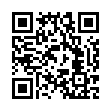
This file has been shared publicly by a user of PDF Archive.
Document ID: 0000336847.